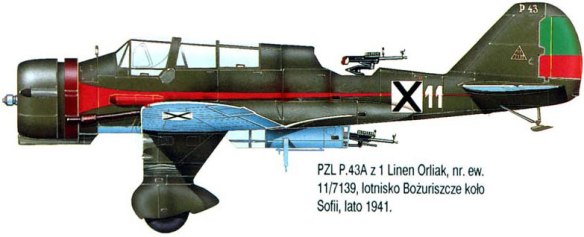
In early 1936 Bulgaria placed an order for 12 P.23s, with the additional requirement of a more powerful engine and an additional forward-firing machine gun. The fuselage was thus redesigned to accept the Gnome-Rhone 14N-01 engine, and the plane was given the designation PZL 43A Tchaika (sea gull in Bulgarian). Because of delays in engine shipments from France, this first series was eventually fitted with Gnome-Rhone 14kfs engines, while additional 42 planes ordered by Bulgaria, designated PZL 43B, received the intended GR 14N-01 engine. At the outbreak of war nine of these aircraft were still at the Warsaw Okecie airfield, and five of them saw combat in the Polish Campaign. The PZL 43 equipped units of the Bulgarian air force never saw front line combat, and were used locally against communist guerillas throughout 1943 and 1944. In September 1944, after Bulgaria switched sides and joined the Allies, the Tchaikas were finally replaced by aircraft of indigenous design.
The Karas was another formerly advanced Polish machine that had fallen behind technologically by 1939. Flown with fanatical bravery, they inflicted heavy losses upon German armored formations.
In 1931 the Polish government sought to acquire a new light bomber based upon the unsuccessful PZL P 13 civilian transport. Several prototypes were then constructed until the cowling was lowered somewhat to improve the pilot’s forward vision. This change gave the new P 23 Karas (Carp) its decidedly humped appearance. It was an allmetal machine with fixed, spatted landing gear and a spacious glazed canopy. The P 23 also mounted a bombardier/tailgunner’s ventral gondola just aft of the main wing. At the time it debuted, the Karas possessed radically modern features such as stressed skin made from sandwiched alloy/balsa wood. This innovation conferred great strength and light weight to the machine. Initial production models were powered by a 590-horsepower Bristol Pegasus radial engine, but their performance proved limited and they served as trainers. Subsequent models featured more powerful engines and greater payload, entering frontline service in 1937. By 1939 P 23s equipped 12 bombing and reconnaissance squadrons in the Polish air force. Bulgaria also expressed interest in the P 23, purchasing 12 and ordering an additional 42 in 1937. Nonetheless, by the eve of World War II the Karas had become outdated as light bombers and helpless in the face of determined fighter opposition.
The initial German blitzkrieg of September 1, 1939, failed to destroy many P 23s on the ground, and they struck back furiously at oncoming armored columns. Several Panzer forces lost up to 30 percent of their equipment in these raids, although many P 23s were claimed by ground fire and enemy fighters. Toward the end of the month-long campaign, a handful of surviving Karas fought their way to neutral Romania. Within two years these machines were reconditioned and flown against the Soviet Union. A total of 253 were built.